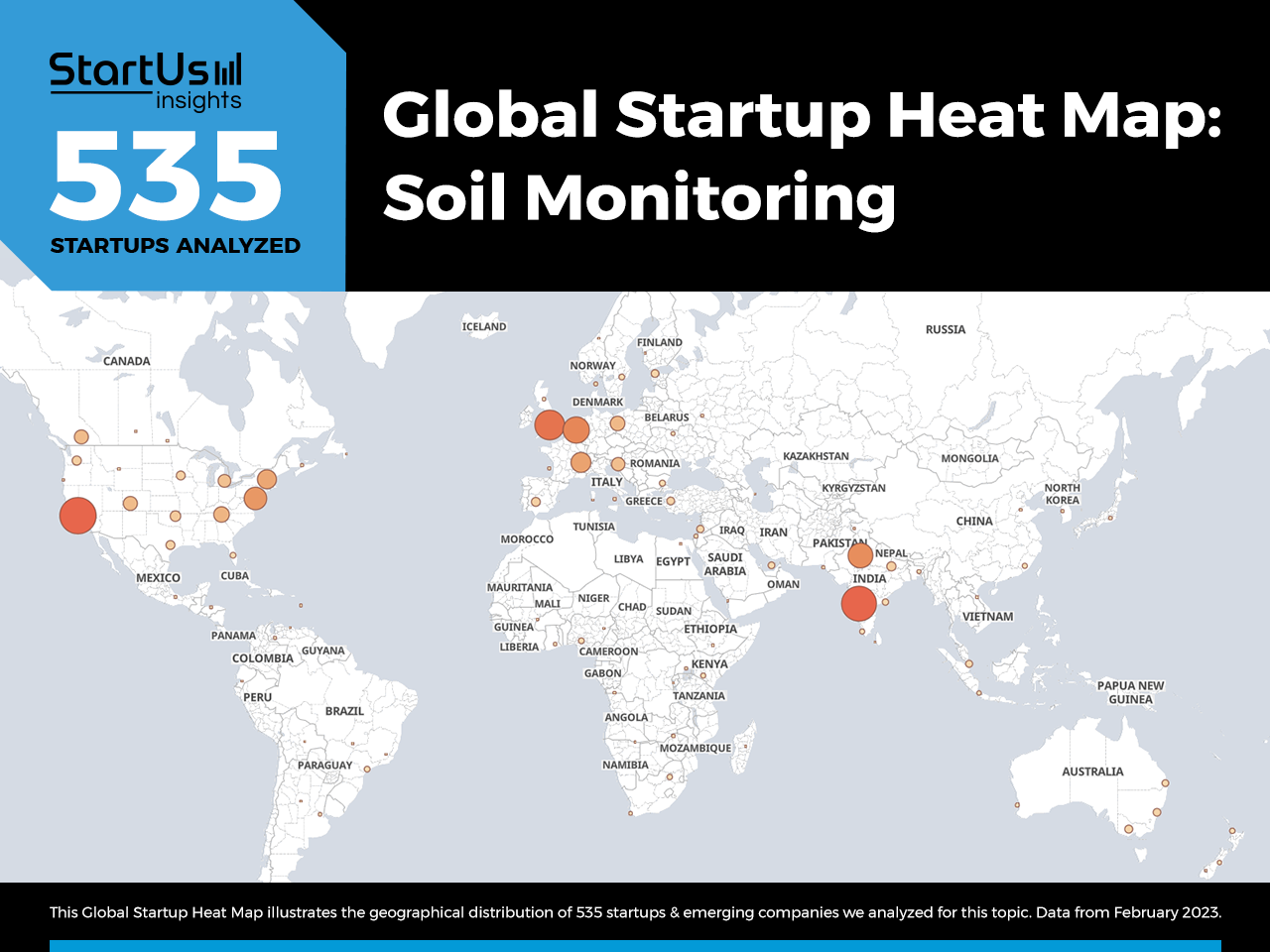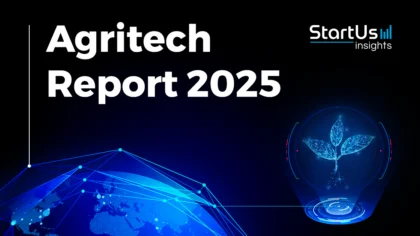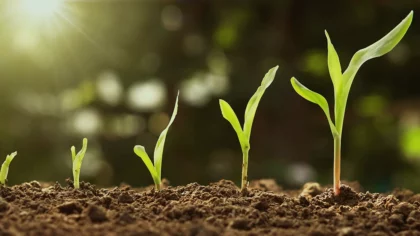Technology trends advancing soil monitoring enable farmers and landowners to gather accurate soil condition data. This enables stakeholders to make informed decisions on land management. For example, startups develop the internet of things (IoT)-enabled humidity and moisture sensors to collect and relay soil data. Aerial imaging and spatial soil characterization enable more efficient and accurate soil monitoring for detecting soil erosion and pests. This research provides the top 10 soil monitoring trends in 2023 we found after analyzing 535 startups and scaleups working in the field. These solutions range from immersive technologies and robotics to blockchain and nanotechnology. Read more to find out how they impact your business.
Innovation Map outlines the Top 10 Soil Monitoring Trends & 20 Promising Startups
For this in-depth research on the Top Soil Monitoring Trends & Startups, we analyzed a sample of 535 global startups & scaleups. The result of this research is data-driven innovation intelligence that improves strategic decision-making by giving you an overview of emerging technologies & startups in the agriculture industry. These insights are derived by working with our Big Data & Artificial Intelligence-powered StartUs Insights Discovery Platform, covering 3 790 000+ startups & scaleups globally. As the world’s largest resource for data on emerging companies, the SaaS platform enables you to identify relevant startups, emerging technologies & future industry trends quickly & exhaustively.
In the Innovation Map below, you get an overview of the Top 10 Soil Monitoring Trends & Innovations that impact 535 companies worldwide. Moreover, the Soil Monitoring Innovation Map reveals 20 hand-picked startups, all working on emerging technologies that advance their field.
Top 10 Soil Monitoring Trends in 2023
- Soil Sensors
- Soil Mapping
- Aerial Imaging
- Soil Robotics
- Advanced Soil Analysis
- Spatial Soil Characterization
- Immersive Technologies
- Nanotechnology
- Soil Biodiversity Analysis
- Blockchain
Tree Map reveals the Impact of the Top 10 Soil Monitoring Trends
Based on the Soil Monitoring Innovation Map, the Tree Map below illustrates the impact of the Top 10 Soil Monitoring Trends in 2023. Startups are developing solutions to improve soil monitoring and analysis for farmers and landowners. Soil sensors allow farmers to minimize soil sampling costs and the time spent on the field. Soil mapping, empowered by artificial intelligence (AI), enables early detection of soil-borne diseases and pests. Additionally, spatial soil characterization and aerial imaging ensure accurate soil analysis and larger land coverage. Immersive technologies aid farmers visualize and analyze soil data, making it easier to identify patterns and take informed decisions. Advanced soil and soil biodiversity analysis as well as nanotechnology further promote sustainable soil practices. Lastly, blockchain brings security and transparency to the collected soil data as well as enables the tracking of various equipment in the supply chain.
Global Startup Heat Map covers 535 Soil Monitoring Startups & Scaleups
The Global Startup Heat Map below highlights the global distribution of the 535 exemplary startups & scaleups that we analyzed for this research. Created through the StartUs Insights Discovery Platform, the Heat Map reveals high startup activity in the US followed by India and Western Europe.
Below, you get to meet 20 out of these 535 promising startups & scaleups as well as the solutions they develop. These soil monitoring startups are hand-picked based on criteria such as founding year, location, funding raised, & more. Depending on your specific needs, your top picks might look entirely different.
Top 10 Soil Monitoring Trends
1. Soil Sensors
The rising need for soil monitoring drives innovations in soil sensors. Startups provide IoT-enabled sensors that collect and relay information regarding various soil parameters to the farmers. They include soil temperature, humidity, and moisture. Startups are also building IoT devices with incident light sensors and pressure sensors to monitor soil health and fertilizer levels. This enables farmers to optimize fertilizer and pesticide application based on soil needs.
Farmsys offers IoT-based Soil Monitoring
Indian startup Farmsys develops Soil Spectra, an IoT soil monitoring sensor. It monitors vital soil parameters like temperature, soil moisture, nitrogen-phosphorus-potassium (NPK) ratio, soil pH, and weather information. The sensor also features a durable, splash-proof design and relays real-time alerts through a companion smartphone app. This provides detailed soil nutrient information that allows farmers to ensure soil sustainability and richer yields.
N-Sense facilitates Nitrate Sensing
N-Sense is a US-based startup that offers a soil nitrate monitoring sensor. It uses Fourier-transform infrared spectroscopy to analyze the spectral signal of nitrates in collected soil samples. This analysis is done before and after applying fertilizers or amendments to fields. Consequently, the sensor enables farmers to determine soil nutrient levels and other characteristics to make informed decisions on management practices. This facilitates the precise application of nitrogen fertilizers, preventing waste.
2. Soil Mapping
Soil mapping solutions provide data on the spatial variability of soil properties in a given area. With artificial intelligence (AI), statistical models, and unmanned aerial vehicles (UAVs), predictive soil mapping identifies soil-borne diseases and pests. It also enables pedological mapping to track the evolution of soil and its reaction to human activities. These maps allow farmers and landowners to compare the variability and soil characteristics of different samples. Startups are using this technology to create high-resolution soil maps to improve crop yields and reduce fertilizer use.
SoilSerdem creates Fertility Maps
US-based SoilSerdem makes soil fertility maps to identify soil quality. The startup combines optimized soil sampling, remote sensing techniques, and geographic information system (GIS)-based mapping to generate soil maps. This allows farmers to leverage data-driven decision-making in crop selection, fertilization, and other soil management practices. Moreover, the startup’s fertility maps enable long-term tracking of soil to monitor and prevent soil erosion or degradation.
Map My Crop creates Soil Productivity Maps
US-based startup Map My Crop provides soil productivity maps. The startup’s proprietary algorithm collects satellite measurements over the last 7 years to benchmark historical yield variability. It gathers soil moisture measurements by analyzing the reflection of electromagnetic radiation from the soil surface. The maps provide data on soil temperature, moisture, and nitrogen levels. These maps provide insights to optimize agricultural resource allocation and profitability as well as save crops from waterlogging and droughts.
3. Aerial Imaging
Drone or UAV-powered aerial imaging enables real-time soil monitoring. Equipped with cameras, drones facilitate soil monitoring in large fields. This ensures the appropriate application of fertilizers, water, seeds, and pesticides, driving precision agriculture. Startups provide different drones that capture a range of images from simple photographs to multispectral and thermal imagery. Some startups also work on drones for detailed topographical mapping, allowing farmers to record soil conditions and plan effective land management strategies.
TerraRad enables Drone-based Topsoil Monitoring
Swiss startup TerraRad offers drone-based topsoil monitoring. The startup’s drones leverage portable L-band radio wave antennas (PoLRas) for soil moisture sensing. With this technology, drones generate high-resolution subsurface soil moisture maps by picking up the microwaves emitted from soil and vegetation. It then calculates the volumetric soil moisture to advance sustainable irrigation and improve soil health.
Anton Tech offers Soil Carbon Monitoring
Motswana startup Anton Tech provides soil carbon monitoring services. The startup’s transboundary disease alert system, Project Anton, aids soil organic carbon (SOC) level monitoring. The startup uses drones to collect hyperspectral images and machine learning to analyze them and detect pests, diseases, and SOC levels. This provides actionable insights for soil treatment.
4. Soil Robotics
Robotics significantly impacts soil monitoring and enables more precise and efficient soil health analysis while reducing labor. Soil robotics also promotes the use of precision agriculture techniques by gathering data on soil conditions and crop growth. This data also allows farmers to optimize irrigation systems. Moreover, robots assess soil compaction levels, which is important for understanding soil health and preventing crop damage.
S-A-M Technologies develops Automated Soil Monitoring Robots
Austrian startup S-A-M Technologies builds automated soil monitoring robots. The startup’s robot, SAM, collects and analyzes soil condition data. Its modular design enables the attachment of different modules or sensors for various agricultural use cases. The robot features IoT sensors that measure soil moisture, pH, nutrient levels, and temperature. S-A-M Technologies also incorporates programmed, autonomous movement to facilitate soil imaging and virtual fencing. The data collected by the sensors are uploaded and analyzed by SAM’s cloud database. Artificial intelligence is then used for anomaly analytics to provide farmers with predictions on soil needs and accompanying remediation techniques.
Vertum Technologies offers Robotic Farming Assistants
US-based startup Vertum Technologies creates robotic farming assistants that integrate IoT-based sensors for soil analysis. These robots feature AI-based plant disease detection and fertilization capabilities. This provides precise recommendations for crop selection and soil management practices. The utilization of soil sensors enables early detection of soil deficiencies, leading to more informed fertilizer applications. The optimization of irrigation schedules through soil sensing is also possible, resulting in increased crop yields and a more sustainable farming environment for indoor farmers.
5. Advanced Soil Analysis
Soil analysis includes methods, such as soil modeling and spectroscopy, to predict the behavior of soil under different conditions. It allows startups to simulate the effects of different soil stimuli on the soil’s physical and chemical properties. Soil modeling identifies effective irrigation schedules and determines optimal amounts of fertilizers. At the same time, spectroscopy identifies factors important for soil quality like soil type, climate, and fertility. Spectroscopy-based solutions also find use in identifying areas of soil degradation such as erosion and nutrient depletion.
Soil Metrics enables Soil Carbon Footprinting
US-based startup Soil Metrics makes a greenhouse gas inventory tool (GGIT). It estimates the greenhouse emissions of different soil management practices. This allows farmers and land managers to quantify greenhouse (GHG) impacts of their soil operations, reducing emissions and increasing sequestration. The tool also enables comprehensive soil modeling for carbon footprinting. It collects data on land use, soil type, climate, and management practices, such as tillage and fertilization. The startup’s GGIT then provides recommendations on soil management practices for improving GHG performance.
Hone offers Rapid Soil Carbon Testing
Australian startup Hone provides a rapid soil carbon testing solution for farmers. The process starts with soil sample collection and transportation to carbon soil processing facilities for baseline measurement and the creation of a spectral model. Hone leverages soil spectroscopy to monitor soil composition and assess soil organic carbon levels. This data allows farmers to make informed decisions on soil health improvement measures. With its cost-effective approach to soil carbon testing, Hone offers farmers a comprehensive solution for soil health assessment and management.

6. Spatial Soil Characterization
Spatial soil characterization provides detailed information on the spatial variability of soil properties and characteristics. This allows farmers and researchers to identify patterns, optimize sampling strategies, and identify soil changes over time. Consequently, spatial soil data powers decision-making concerning land use, conservation, and other environmental management practices. Startups are also leveraging satellite technologies, such as GIS and GPS, to perform spatial analysis on soil data. This enables them to identify patterns in soil property distribution, like areas particularly susceptible to erosion or nutrient depletion.
Seqana offers Satellite-based Soil Carbon Monitoring
German startup Seqana develops a soil carbon monitoring platform. It utilizes satellite imagery and machine learning to measure the carbon stocks in the soil. This enables the monitoring, reporting, and verification (MRV) of regenerative agriculture. Further, the platform delivers high-quality data for soil monitoring while hyperspectral imaging provides insights into dynamic soil influences. This allows farmers and land managers to qualitatively assess soil and vegetation development.
inFarmer develops a Soil Health Monitoring Platform
Pakistani startup inFarmer offers an eponymous soil health monitoring platform. It uses satellite imagery with a spatial resolution of up to 10 meters to analyze and compute soil health and water stress. Farmers and landowners access the platform through smartphones or web browsers. It also sends automated alerts on irrigation and fertilizer recommendations as well as provides soil health predictions. This enables farmers to better maintain their soil and increase crop yield.
7. Immersive Technologies
Farmers integrate immersive technologies, such as virtual reality (VR) and augmented reality (AR), to improve the efficiency and accuracy of soil data collection and analysis. Creating realistic simulations of different soil environments using VR allows researchers and farmers to test and evaluate management practices. This aids in identifying areas of soil compaction or areas that lack sufficient irrigation. Similarly, AR overlays information on soil conditions, crop growth, and other data on top of real-world landscapes. This allows farmers and researchers to easily identify areas that may require attention, like hotspots of pest infestation or nutrient deficiencies.
Terraview offers AR-powered Soil Analysis
Spanish startup Terraview provides AR-powered soil analysis. The startup’s app, Vine Click, uses AR to overlay soil data onto the camera view, providing farmers with a clear understanding of soil conditions in real time. It Identifies the exact locations of macro and micronutrient deficiencies causing loss of yield. The app also enables farmers to scan the soil with their mobile camera to collect soil health and nutrient information. This information enables the farmer to perform pest control, deficiency management, and more, promoting soil health and productivity.
Wolfberry advances AR Soil Visualization
US-based startup Wolfberry develops AR soil visualization technology to provide an immersive soil monitoring experience. The startup provides IoT-enabled sensors that monitor and respond to environmental conditions. For example, its soil and pH sensors detect dry soil and out-of-balance pH. This triggers an actuator to turn on a water pump and deliver water and nutrients to the soil. Wolfberry’s AR dashboard then relays the data and real-time soil insights to farmers. Additionally, AR soil visualization allows farmers to view and interact with soil data using a smartphone or tablet. This enables the real-time monitoring of soil properties, such as texture, structure, and fertility, as well as soil contaminants and erosion.
8. Nanotechnology
Researchers are developing nanoparticles, such as gold and silver nanoparticles, that find use as sensors in soil monitoring. They detect specific chemicals, like heavy metals or pollutants, in soil. Startups are also developing nanocomposites that improve soil water retention and nutrient availability. Nanosensors measure a variety of parameters, like pH, temperature, moisture, and nutrient levels. Additionally, they integrate into other soil monitoring systems to collect and analyze data in real time, providing accurate data on soil conditions.
IntelliFertilizer simplifies Soil Condition Monitoring
Pakistani startup IntelliFertilizer provides a nano-coating that enables soil condition monitoring. It is applied to the surface of the soil sensor with fertilizer release capability. This improves the sensitivity of the sensor, making it more effective at detecting specific compounds in the soil. The nanocoated sensor also collects data on soil nutrient needs in various weather conditions. The nano-coating then enables the timely release of custom soil additives that are beneficial for crops. Consequently, this allows the nutrients to be released at a specific time, ensuring that the soil receives the optimal amount of nutrients at the right time.
Nangatech provides Oxygen Monitoring Nanobubbles
Polish startup Nangatech offers nanobubbles that monitor and enhance soil oxygen levels. The startup uses its sonication process to create nano-oxygen bubbles. They enable constant monitoring of oxygen in the irrigation water and maintain it at high levels to enhance the productivity of greenhouse crops. Once the nanobubbles detect that the soil oxygen levels are low, the oxygen present in them dissolves into the soil water. This stabilizes the oxygen levels in the soil, promoting plant growth and preventing root rot.
9. Soil Biodiversity Analysis
Soil biodiversity analysis offers a deeper understanding of the microbes and fauna present in soil and their role in maintaining soil health. By analyzing the genetic material of microbes, scientists determine the diversity and abundance of different microorganisms. This information drives the development of targeted management strategies for improving soil health. Increasing the population of keystone species is one such strategy. Startups are also using automated soil sampling to identify the levels of bioindicator species, like earthworms, to assess soil health. This helps in understanding the impact of climate change on soil health.
Vidacycle builds a Soil Biodiversity Monitoring App
UK-based startup Vidacycle offers Soilmentor, a soil biodiversity monitoring app. It enables landowners to monitor soil health by testing soil biology, chemistry, and physics. The app also uses earthworm count as an indicator of soil health. Once farmers upload the earthworm count, it observes and analyzes the data and suggests necessary soil management practices. The app also connects other farmers to share information to improve soil health.
Harvest Genomics provides Soil Microbiome Analysis
Canadian startup Harvest Genomics delivers soil microbiome analysis to farmers. The startup combines DNA sequencing and computational analysis to decode soil microbiome signatures. It then identifies the alpha and beta diversity soil indices by performing DNA amplicon analysis (DAA). These indices indicate the presence and relative abundance of microorganisms in the soil sample. Analyzing the abundance of soil microorganism activity between different agriculture practices allows farmers to better understand soil fertility. The data allows them to quickly react to potential issues and shift to better soil management strategies.
10. Blockchain
Soil management projects now use blockchain technology to improve the accuracy and transparency of soil monitoring. The data collected from soil sensors and other monitoring devices are stored in a decentralized, tamper-proof ledger. This ensures data security and tamper-proofing. As a result, blockchain-based data management enables more accurate analysis and predictions about soil health and crop yield. Startups are also using blockchain to track the movement of soil and agricultural products throughout the supply chain. This improves transparency and traceability for farmers and landowners.
Urjalinks enables Blockchain-based Soil Monitoring
Indian startup Urjalinks creates Cropulse, a soil health monitoring hand-held sensor. It analyzes soil nutrients such as NPK and other micronutrients. The sensor uses a near-infrared (NIR) sensor connected to a blockchain-based AI platform for soil and crop monitoring. This ensures the validity and security of the data acquired. Soil sensing technologies are conventionally capital-intensive, limiting their access to small-scale farmers and landowners. The startup’s solution is a low-cost alternative that provides soil health and nano-fertilizer recommendations.
Dimitra offers a Connected Soil Monitoring Platform
Belizean startup Dimitra develops an eponymous blockchain-powered connected soil monitoring farmer platform. It combines machine learning, IoT, satellite and drone imagery, genomics, and advanced farming research to provide in-depth soil analysis. The platform allows small-scale farmers to record their farming activities, create detailed soil dashboard reports, and receive insights to improve soil health. Moreover, blockchain ensures farmer anonymity, data security, document auditability, tracking, and immutability. It also maintains privacy between the government, corporations, and farmers. These features aid farmers in increasing yields, reducing expenses, and mitigating the risk of data loss.
Discover all Soil Monitoring Trends, Technologies & Startups
The future of soil depends on sustainable farming practices. From drones to satellites and sensors, startups are making it easier for farmers to gather data about the condition of their soil to make informed decisions. Additionally, the integration of genetically enhanced microbes and nanobots will enhance the accuracy and efficiency of soil monitoring. The use of quantum computing in soil data analysis further holds the potential to detect and predict erosion and soil anomalies faster and more accurately.
The soil monitoring trends & startups outlined in this report only scratch the surface of trends that we identified during our data-driven innovation & startup scouting process. Among others, IoT, blockchain, and regenerative agriculture will transform the sector as we know it today. Identifying new opportunities & emerging technologies to implement into your business goes a long way in gaining a competitive advantage.











